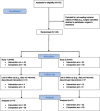A descriptive analysis of pediatric post-tonsillectomy pain and recovery outcomes over a 10-day recovery period from 2 randomized, controlled trials
- PMID: 32440612
- PMCID: PMC7209815
- DOI: 10.1097/PR9.0000000000000819
A descriptive analysis of pediatric post-tonsillectomy pain and recovery outcomes over a 10-day recovery period from 2 randomized, controlled trials
Abstract
Pediatric tonsillectomy involves an often painful and lengthy recovery period, yet the extended recovery process is largely unknown. This article describes postoperative recovery outcomes for 121 children aged 4 to 15 (mean 6.6 years, SD = 2.3) years enrolled in 1 of 2 clinical trials of analgesia safety and efficacy after tonsillectomy. Postoperative analgesia included scheduled opioid analgesic plus acetaminophen/ibuprofen medication use (first 5 days) and "as-needed" use (last 5 days). Clinical recovery as measured daily by the Parents' Postoperative Pain Measure (PPPM; an observational/behavioral pain measure), children's self-reported pain scores, side-effect assessments, need for unanticipated medical care, and satisfaction with recovery over 10 days was assessed. Higher Parents' Postoperative Pain Measure scores were correlated with poorer sleep, receipt of breakthrough analgesics, distressing side effects, higher self-reported pain scores, and need for unanticipated medical care. Higher self-reported pain scores were associated with more distressing adverse events, including nausea, vomiting, insomnia, lower parent satisfaction, and unplanned medical visits and hospitalizations. Pain and symptoms improved over time, although 24% of the children were still experiencing clinically significant pain on day 10. Scheduled, multimodal analgesia and discharge education that sets realistic expectations is important. This study adds to the emerging body of literature that some children experience significant postoperative pain for an extended period after tonsillectomy.
Keywords: Acute pain; Breakthrough pain; Pain assessment; Pain management; Pediatrics; Tonsillectomy.
Copyright © 2020 The Author(s). Published by Wolters Kluwer Health, Inc. on behalf of The International Association for the Study of Pain.
Conflict of interest statement
The authors have no conflicts of interest to declare.Sponsorships or competing interests that may be relevant to content are disclosed at the end of this article.
Figures



References
-
- Azevedo C, Carenzi L, Queiroz D, Anselmo-Lima W, Valera F. Clinical utility of PPPM and FPS-R to quantify post-tonsillectomy pain in children. Int J Pediatr Otorhinolaryngol 2014;78:296–9. - PubMed
-
- Baugh RF, Archer SM, Mitchell RB, Rosenfeld RM, Amin R, Burns JJ, Darrow DH, Giordano T, Litman RS, Li KK, Mannix ME, Schwartz RH, Setzen G, Wald ER, Wall E, Sandberg G, Patel MM, American Academy of O-H, Neck Surgery F. Clinical practice guideline: tonsillectomy in children. Otolaryngol Head Neck Surg 2011;144(1 suppl):S1–30. - PubMed
-
- Berghmans JM, Poley MJ, van der Ende J, Veyckemans F, Poels S, Weber F, Schmelzer B, Himpe D, Verhulst FC, Utens E. Association between children's emotional/behavioral problems before adenotonsillectomy and postoperative pain scores at home. Paediatric Anaesth 2018;28:803–12. - PubMed
-
- Boss EF, Marsteller JA, Simon AE. Outpatient tonsillectomy in children: demographic and geographic variation in the United States, 2006. J Pediatr 2012;160:814–19. - PubMed
-
- Cai Y, Lopata L, Roh A, Huang M, Monteleone MA, Wang S, Sun LS. Factors influencing postoperative pain following discharge in pediatric ambulatory surgery patients. J Clin Anesth 2017;39:100–4. - PubMed
Grants and funding
LinkOut - more resources
Full Text Sources
